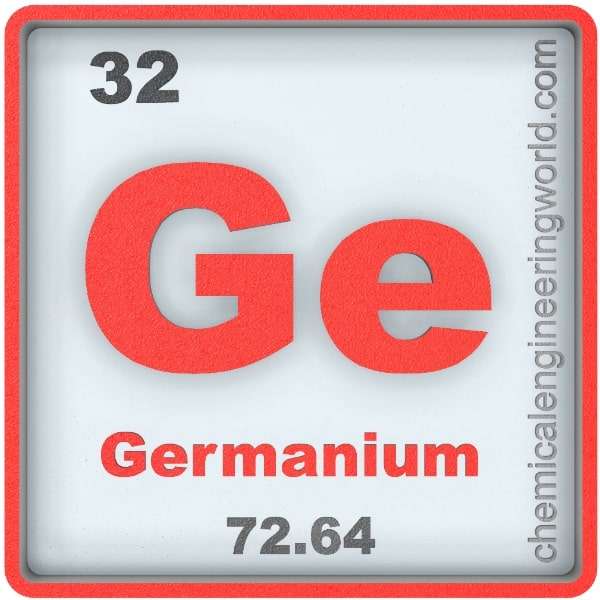Germanium Element Properties and Information

Germanium Element Properties and Information
Germanium is the thirty-second element on the periodic table. Elements are arranged in the periodic table on the basis of the atomic number. Atomic number is the number of protons in the nucleus of the atom. Germanium has an atomic number of 32. It is located in the Group 14 and Period 4 of the periodic table of elements. It is denoted by Ge. The name is derived from the Latin name of Germany, ‘Germania’.
Germanium ores are one of the rarest of ores present on earth. The concentration of germanium in Earth’s crust is 1.6 ppm. Only few minerals contain germanium in appreciable quantities such as argyrodite, birartite, and germanite.
Albin Weisbach was passed an unusual ore in 1885 which he certified it to be a new mineral. He asked Clemens Winkler to analyse it. Upon analysis it came to light that the mineral was 75% silver, 18% sulfur, and 7% could not be explained. It was announced in 1886 that the unexplainable portion of the mineral was a new metal which was named Germanium. Mendeleev had already predicted such an element to exist and hinted that its location would be below silicon on the periodic table.
Physical Properties
- Germanium is a silvery-white semi-metallic element.
- The atomic mass of germanium is 72.59
- The melting point of germanium is 937°C
- The boiling point of germanium is 2830°C
- The density of germanium is 5300 in S.I. units at 20°C
- Germanium is one of the few elements which expand when solidified from its molten state.
- Crystalline germanium is popularly used for semiconductor applications.
- Alloy of germanium, uranium, and rhodium was the first composite metal which was discovered to become a superconductor under strong electromagnetic field.
- Germanium has five naturally occurring isotopes; germanium-70, germanium-72, germanium-73, germanium-74, and germanium-76.
Chemical Properties
- Elemental germanium starts to oxidise in air at around 250°C.
- Germanium is insoluble in dilute acids and alkalis.
- Germanium dissolves slowly in hot concentrated sulphuric and nitric acid.
- Germanium reacts violently with molten alkalis thus forming germanates.
- Germanium is known to form binary compounds with chalcogens. Chalcogens are chemical elements in the Group 16 of the periodic table. For example, germanium disulfide and germanium diselenide.
Methods of Production
Extraction: Sulfide ores of germanium are roasted in order to convert germanium sulfides to germanium oxides. Further they are converted to germanates and leached by sulfuric acid. The germanium gets precipitated out.
Relevance in Chemical and Related Industries
Catalyst: Germanium dioxide is used as a catalyst in the process of production of polyethylene terephthalate.
Relevance in Other Industries
- Optics: Germania has high refractive index and low optical dispersion. These make it attractive to have applications in microscopy, fibre optics and infrared optics industries. About 65% of the total germanium produced goes in the applications of the optic industry; 35% in fiber optics and 30% in infrared optics.
- Electronics: Silicon-germanium alloys are one of the most important materials for high speed integrated circuits.
Health Effects on Exposure
Inhalation: If gaseous germanium compounds are inhaled then they cause, abdominal cramps, irritation and pain in eyes, burning sensations, abdominal cramps, cough, and skin redness.
Effects on Surroundings
- Flammable: Some gaseous germanium compounds are extremely flammable when mixed with air. They can even be explosive in nature and cause damage to equipments, environment, and life if get burnt.
References:
https://www.rsc.org/periodic-table/element/32/germanium
https://www.lenntech.com/periodic/elements/ge.htm
https://en.m.wikipedia.org/wiki/Germanium
































